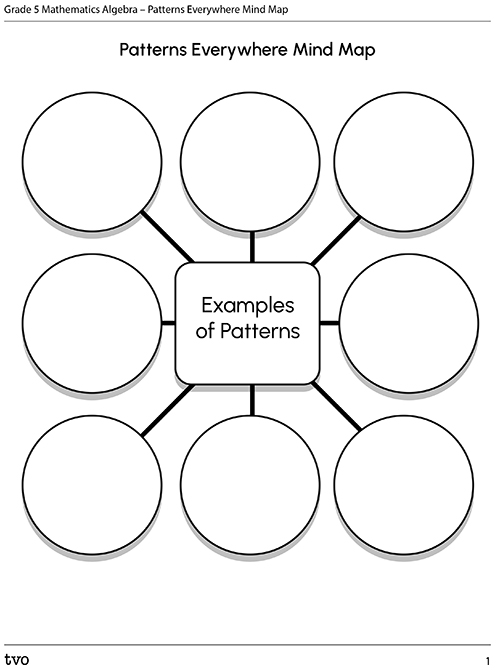Minds On
Patterns around us

Patterns are everywhere! Let's take some time to brainstorm where you can find patterns around you.
Think about your school, home, or the community
You can create a list, take photographs, or use the following fillable and printable Patterns Everywhere Mind Map document to record the patterns you find. You may also use any other method of your choice.

Press the ‘Activity’ button to access the Patterns Everywhere Mind Map.
Activity (Open PDF in a new tab)Action
Patterns
A number pattern is a sequence of numbers that is formed according to a rule.
A number pattern may:
- use any of the four operations +, −, ×, ÷ or a combination of them
- be a repeating pattern that includes numbers, e.g., 1, 2, 3, 1, 2, 3, 1, 2, 3. There isn’t always an operation involved.
As mathematicians, we always look for patterns and make guesses or conclusions.
Click on each tab to learn more about the different types of patterns.
A repeating pattern – a pattern where we make predictions based on the core or repeating part of a pattern.
The illustration shows a series of shapes: triangle, square, triangle, trapezoid, triangle, square, triangle, trapezoid. This is an ABCD pattern where A = triangle, B = square, C = triangle, D = trapezoid. There is also an AB pattern where A is large and B is small. Did you notice it?
A growing pattern – a pattern where we find the next number by adding or multiplying something to the number before it.
Consider the following example. We start at 4 and add 7. We would get 11. Then, we add 7 again to the new number and get 18. We repeat adding 7 to get a new number every time.

A shrinking pattern – a pattern that has a constant decrease from term to term.
For example: we start at 99 and subtract 10. We would get 89. Then, we subtract 10 again from the new number and get 79. We repeat subtracting 10 to get a new number every time.

Number patterns
Task 1
Find the missing numbers in each pattern and record the rule.
Check the first example that has been completed for you.
a) 5, 10, (Blank), 20, 25, (Blank)

The missing numbers are 15 and 30.
Rule: Start at 5 and add 5.
Now you try it!
You can record your answers using a method of your choice. You may use the number line provided for each question to help support your thinking.
b) 10, 13, (Blank), (Blank), 22

Click the ‘Reveal’ button to check your answer.
c) 99, (Blank), 81, 72, (Blank), (Blank)

Click the ‘Reveal’ button to check your answer.
d) 1, (Blank), 1.5, (Blank), 2, 2.25

Click the ‘Reveal’ button to check your answer.
e) 7, (Blank), 11, (Blank), 15, 17

Click the ‘Reveal’ button to check your answer.
Task 2
Complete the patterns according to the pattern rule. Extend the pattern to the 4th term, showing the first 4 numbers in the pattern. Then, decide if it is a growing pattern or a shrinking pattern. Consider the following example:
Start at 125 and subtract 25.
What type of pattern is shown?
Recall that a growing pattern is a pattern that has a constant increase from term to term and a shrinking pattern is a pattern that has a constant decrease from term to term.
Click the ‘Reveal’ button to check your answer.
Now, complete each of the three following patterns.
a) Start at 58 and add 20. What is the 4th term? What kind of pattern is it?

Click the ‘Reveal’ button to check your answer.
The pattern is 58, 78, 98, 118.
So the 4th term is 118.
This is a growing pattern.b) Start at 20 and add 2.5. What is the 4th term? What kind of pattern is it?

Click the ‘Reveal’ button to check your answer.
The pattern is 20, 22.5, 25, 27.5.
So the 4th term is 27.5.
This is a growing pattern.c) Start at 1 and add 0.20. What is the 4th term? What kind of pattern is it?

Click the ‘Reveal’ button to check your answer.
The pattern is 1, 1.2, 1.4, 1.6.
So the 4th term is 1.6.
This is a growing pattern.Geometric patterns
Let’s consider some geometric patterns and determine their rule.
What do you notice?
Series of shapes as follows: one blue square, one green pentagon, one blue square, two green pentagons, one blue square, three green pentagons.
It is a growing pattern.
- The first term is 1 blue square and 1 green pentagon.
- The second term shown has 1 blue square with 2 green pentagons.
- The third term has 1 blue square and 3 green pentagons.
What would the next 2 terms be?
Did you notice the number of pentagons increase by 1 each time?
Click the ‘Reveal’ button to check your answer.
Task 1
Consider the following pattern. How would you describe it? How would you extend it?
Block of 2 tiles followed by block of 4 tiles followed by block of 6 tiles followed by block of 8 tiles.
Did you notice that the pattern started at 2 and added 2 each time?
Click the ‘Reveal’ button to check your answer.
Task 2
Describe and extend the following pattern to the next 3 terms. What kind of pattern is shown?
Record your answers using a method of your choice.
The first tower contains circles arranged in 3 columns of 8. The second tower contains circles arranged in 3 columns of 7. The third tower contains circles arranged in 3 columns of 6.
Click the ‘Reveal’ button to check your answer.
The first tower contains circles arranged in 3 columns of 5. The second tower contains circles arranged in 3 columns of 4. The third tower contains circles arranged in 3 columns of 3.
Did you know?
When bricks of different colours are used to make a regular pattern, it is called diapering.
What kind of pattern is shown in the brick? How would you describe it?

Beading has been part of many cultures for centuries.
What kind of pattern is presented? How would you describe it?
Eight rows are shown. How many beads would be in the 12th row?

Click the ‘Reveal’ button to check your answer.
There will be 12 beads in the 12th row.
Did you record any patterns like these in the Minds On section?
Consolidation
Patterns

Name, describe, and give an example of repeating, growing, and shrinking patterns.
Describe a pattern you found and give a pattern rule.
Record your thoughts using a method of your choice.
Thinking back
Let's think about what we have learned by considering these questions:
- What did you find most challenging when completing this task?
- What strategies did you use when you found yourself struggling or frustrated with a concept during this activity?
Reflection
As you read through these descriptions, which sentence best describes how you are feeling about your understanding of this learning activity? Press the button that is beside this sentence.
I feel...
Now, record your ideas using a voice recorder, speech-to-text, or writing tool.
Connect with a TVO Mathify tutor
Think of TVO Mathify as your own personalized math coach, here to support your learning at home. Press ‘TVO Mathify’ to connect with an Ontario Certified Teacher math tutor of your choice. You will need a TVO Mathify login to access this resource.
TVO Mathify (Opens in a new tab)

